您好 (ni hao),
You have surely recognized (or not) the reference to the adventures of Tintin, the comics series by the Belgian cartoonist Hergé… I’ll let you guess the stopover? Come on, make a small cultural effort. I’ll give you another hint: it is the city where Tintin traveled to meet a Japanese business person named Mitsuhirato! Later on, when he managed to get out of jail after some misadventures, he had an anonymous rendezvous on T’ai P’in Lou Street. Congratulation, welcome to the Asian continent with a stop in Shanghai. Contrary to my traditional habit, the astonishing landscapes forged by “Mother Nature” are not my top priority in Asia, but rather the urban landscapes forged by Man (with a large or a small m)… Sometimes we wonder if some buildings do not defy the laws of nature… some architects seem to have delusions of grandeur (of buildings) ?

Pudong by night
Shanghai, also known as the “Paris of the East” and “Pearl of the Orient” looks like a forest of skyscrapers, some among the tallest in the world… and the race to build the most towering continues as new, ever taller, ones are already under construction in Pudong, the business district. In Chinese, Pudong means Eastern Huang or east of the Huangpu River, which is where the business district lies. This area is home to the tallest buildings, including the famous “Oriental Pearl Radio and TV Tower” (东方 明珠 电视塔 pronounced Dōngfāng míng zhū Dianshi Tǎ uh… good luck with the pronunciation !). At 1,535 feet it has become the symbol of Shanghai. It was the tallest structure in China between 1994 and 2007. It was then surpassed. For a short period, the tallest in Pudong district was the “Bottle opener”, rising to 1,614 feet and being the eighth tallest building in the world and the fourth highest structure in China. The “Bottle opener” features an observation deck 1,555 feet above ground. I let you guess which building it is… the name has a direct relationship to its design. But the race goes on: in 2013, Shanghai Tower at 2,073 feet became the second tallest building in the world and the tallest in China. If Pudong impresses by day, at night, we discover the full splendor of Pudong by night when all the buildings are lit, and the illuminated boats sail past on the river. It is hard to imagine that until the 1990s, Pudong was only farms.
Another area close to People’s Square in the Huangpu district rivals Pudong with its extraordinary architecture. In this vicinity on the “people’s Square” (I’m not making this up!) stands the Shanghai Museum, whose architecture reflects Chinese cosmogony: a round top and a square base, symbolizing the ancient perception of the world as “round sky and square earth”, the two poles between which men work. This museum is home to rich cultural collections, over 120,000 pieces, and is a showcase for ancient Chinese Art. Near the museum is the vast Shanghai Grand Theater with an architecture just as extraordinary. The building was designed by Arte Charpentier, a French architecture design company founded by Jean-Marie Charpentier. It owes the nickname “Crystal Palace” to the light installation at night that make the entire site resemble a Crystal Palace.

The Shanghai Grand Theater
Over 23 million people work in Shanghai; I say “work” since the means of identifying residents is through their employer… so this figure is well below the real number of inhabitant. Early morning, as soon as 6am, if we walk in Fuxing Park and gardens, for instance, we soon realize that all green spaces are assaulted by an army of practitioners of Tai Chi, sword dance, fan dance, all sort of traditional dances, players of cards, mahjong, and passionate of kite. There is something for every taste! For us Europeans, these moments seem magical.
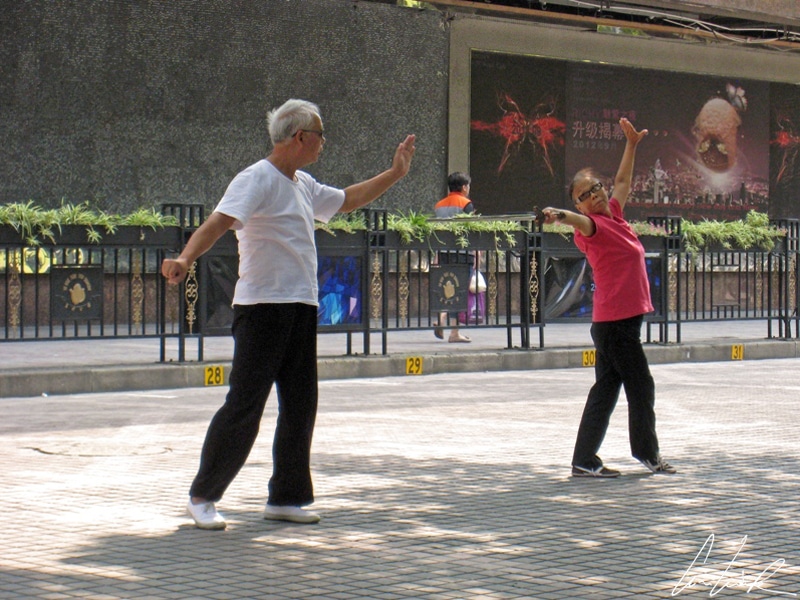
Fuxing Park and gardens – Sword dance
Another unlikely place full of odd customs for us is the insect market, one of the few remaining traditional markets in Shanghai and located just South of People’s Square. Hundreds and hundreds of small boxes containing locusts and insects of all kinds are arranged on shelves. In choosing locusts people follow special rituals! They hold a lamp in one hand and a small stick in the other. They open the box and check that the cricket is receptive, that is, alive and healthy. Some people spend hours inspecting and observing, before buying the best species for a locust fight, known by its nickname Jiminy, which will perhaps allow the buyer to earn some money ! And yes, even if people buy these insects as pets, many locusts are still intended to be used in combat, which is very popular. Purchasers, train their little champion in the hope that it will win duels and thus enable them to earn a few yuan! The locusts are trained to fight or adopted for their particular song. There is a “real industry” of the locust: you can buy a multitude of accessories for them, such as a table service for crickets in ceramic, cute little boxes in wood or bamboo for transport, tiny nets to catch them. Frankly, a visit to the insect market provides a total change of scenery.
Let’s finish with a gastronomic curiosity: the hundred-year-egg or thousand-year-egg also known as the preserved egg, century egg or pidan. This Chinese delicacy is made by preserving duck, chicken or quail eggs in a mixture of clay, ash, quicklime, tea, soda, brown rice and salt (for the base) for several weeks to several months. The eggs then acquire a texture, a distinctive color and a sweet and sharp taste at the same time… personally, I did not dare to take this gastronomic step !
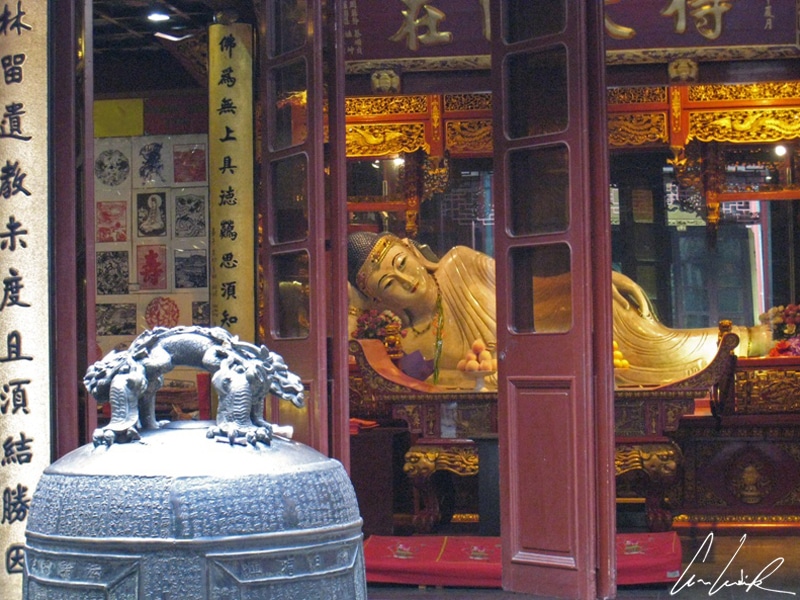
Jade Buddha Temple – Jade Buddha statue
At the heart of the modern city of Shanghai, west of Renmin Lu, is the old city, the oldest inhabited part of Shanghai, showing everyday life in China before modernization. Small streets, called hutongs, narrow, congested and winding, are lined with typical Chinese houses with red and gold roofs. Despite the artificial atmosphere, it is an excellent place to stroll and buy some “Chinoiserie”. When we are overwhelmed with shopping and crowds, we can go to relax in the heart of Yu Garden. A zig-zag bridge provides access to the garden is of itself a curiosity… It seems that evil spirits do not know how to turn corners, and consequently the zig-zag bridge keeps them away from the garden. If you are not up for an irrational explanation, there is also a rational explanation: the Zig-zags compel the visitor to look successively to the right and left of the bridge and to admire the surrounding landscape (QED). The garden looks like a miniature world: earth piles represent hills, small streams are rivers, a pond the sea or ocean. We go through doors of different shapes, such as the round door called the door of the moon, to access one path or another.
To conclude our overview of the city, a must-see in Shanghai is the Jade Buddha Temple. The temple is built around several rooms containing a large collection of Buddhas, Buddhas, Buddhas… and more Buddhas. The atmosphere is peaceful, and the colorful Buddhas and drapes are beautiful. This temple was built in 1928, replacing an old temple destroyed during the revolution that overthrew the Qing Dynasty. The temple houses two Jade Buddha statues imported to Shanghai from Burma by a Buddhist monk called Huigen. One of the statues, a sitting Buddha, 1.90m high, was carved from a single piece of white jade and inlaid with precious stones (emerald and agate). The statue represents the Buddha in meditation and enlightenment (photography is prohibited). Another statue depicts a reclining Buddha, 96 centimeters long, and symbolizes the good fortune of rest – photographs authorized this time !
- Ville de Pudong en Chine

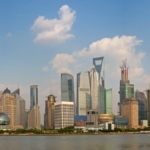
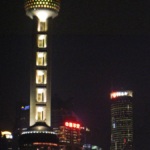
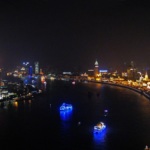

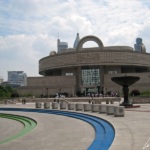
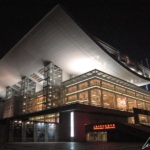


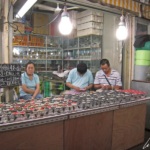
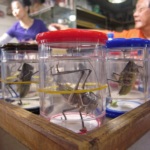

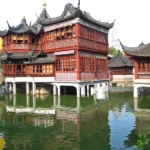
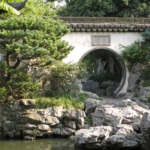
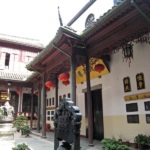
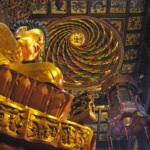



I can’t believe you didn’t eat the egg 😛 Loved your pictures!!
Thank you 😉 I was told that the white has rather rubber-like texture like very hard gelatin or in fact, it kind of feel like you are chewing egg-size gummy bear !
Eek, I couldn’t eat that egg! I’d probably gag.
This is a lovely area though. I’d want to see that Buddha temple.
Generally century eggs must be cut into slices and eaten with vinegar – a must! will improve flavour – and ginger/hot pepper… I’m sure you will enjoy a serene and mystical walk in the Yu Garden, by giving tribute to the largest reclining Budhha made of marble in the Jade Buddha Temple 😉
What a great peek you gave me into this world. I may never reach there but would love to. I may have to skip the egg but would like to check out the insect market!
Ah, ah this curious market selling all manor of creepy crawlies and other things you’d probably not want to get too close to ! If you can put up with their incessant chirping apparently crickets make very good low-maintenance pets – all they need is a few fresh grubs each day! Cricket fighting is still today a popular pastime…
I’ve been to Shanghai and absolutely love it. Specially the Bund and shopping market. The night stroll with coffee at Bund was just awesome.
Shanghai is a sleepless city in China. Nightlife in this city is quite rich ! The Bund is a gorgeous riverfront boardwalk: its view of the city and striking skyline makes for a great photo 🙂 Shopping in Shanghai is an experience of its own, this is why travellers from all over Asia visit Shanghai with the intention of shopping, some of them even arrive to Shanghai with empty suitcases !
I never knew that Shanghai, is also known as the “Paris of the East” and “Pearl of the Orient” !I can totally see why! And this post really sparked my wanderlust, thank you very much! I need to find a way to travel asap!
The city also offers a great mix of old and new. On the one hand you can see old-school produce markets in the streets, eat traditional cuisine, and witness time-honored customs, but on the other hand you can see a rapidly expanding skyline that is so gleaming and futuristic. Shanghai should definitely be on your bucket list. If it’s not, it soon will be… 😉
Beautiful pictures! I would not dare eat the preserved egg either. I heard about it several years ago and when I saw what it looked like, I was DONE! Nope, not gonna happen. lol. Great post.
Thank you 🙂 I like to say that it is an acquired taste for century egg but it is more like eating durian. You either like it or you hate it. My advice is not to try it until one day when you are as hungry as hell…
My boyfriend has tried that egg. This was an informative post, and I learned so much about Shanghai. I hope to visit one day. I would love to visit a Budapest temple one day.
Really, he tried these eggs ? What does a century egg taste like ? I heard that the taste is almost the same as a hard boiled egg except as you masticate there is a slight scent that goes through your nostrils… The Jade Buddha Temple is beautiful but it is a popular stop for tour buses, so be prepared for crowds !
I will pass that egg but would love to explore the other things that Shanghai has to offer! I love its stunning skyline!
It’s a city that is just alive and buzzing. As soon as the sun goes down, countless of lights will spangle the sky in each corner of the intriguing and sleepless Shanghai city that never lacks of a cool place to hang out until the next morning 🙂
I once went to Beijing and didn’t have the best experience there so have been putting off going to Shanghai. I’ve been really intrigued by it recently though and want to visit soon. Your photos are amazing and I would have skipped the egg too 😛
This city, maybe more than anywhere else, is a dramatic mix of East and West. It is also an ideal destination for street food lovers – except the eggs 😉